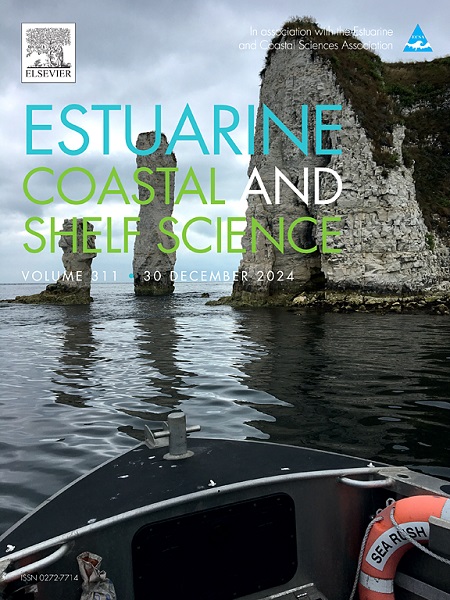Sedimentary and faunistic effects of medium-deep sand mining along the Dutch Coast
IF 2.6
3区 地球科学
Q1 MARINE & FRESHWATER BIOLOGY
引用次数: 0
Abstract
This paper presents the results of a study into the ecological long-term effects of medium-deep sand extraction along the Dutch coast. A comparison was made of the benthic fauna in and outside medium deep extraction pits of various ages, ranging between 2 and 12 years. The pits and reference areas were also compared in terms of water depth, median grain size, silt content and percentage of organic matter.
The water depth of all sand extraction pits was on average 4 m larger than the surrounding reference areas. The average silt content in the extraction pits had increased by a factor 4 compared to the surrounding reference areas. The average silt content in the pits was 9.5 %. This increase differed between pits (0 and 46 %). The percentage of organic matter had almost doubled from 0.87 % in the reference areas to 1.50 % in the pits.
The medium-deep sand extraction pits are faunistically characterized by a higher average macro-benthic biomass and density but the number of species shows no clear difference with the reference areas. Faunistic heterogeneity in the pits is lower than in the surrounding reference areas. The macro-fauna in the pits is characterized by the greater abundance of deposit feeders and interface feeders while the benthic fauna in the reference areas is characterized by bivalves i.e. filter feeders. Small demersal fish did not show clear trends although some species, such as sandeel, showed a difference in abundance between pit and reference area. The effect of age of the mining pit on faunistic composition could not be separated from differences related to geographical position.
The results of this study show that recolonization of a newly mined medium deep sand extraction pit is fast but that the complete recovery and return of the original benthic fauna in these pits can be a very long process. The sedimentary differences between the pits suggests that recovery depends on the abiotic environment. The data suggest that by moving from shallow mining pits to medium deep pits a critical depth is passed beyond which hydrographical changes alter the settlement of fines and determine the composition of the macrofaunal community.

荷兰海岸中深层采砂对沉积和动物群的影响
本文介绍了一项关于荷兰海岸中深层采砂对生态长期影响的研究结果。对2 ~ 12年不同年龄的中深采掘坑内外底栖动物进行了比较。对坑区和对照区进行了水深、中位粒径、淤泥含量和有机质百分比的比较。所有采砂坑的水深平均比周围参考区域大4 m。与周围参考区域相比,采掘坑的平均粉砂含量增加了4倍。坑内平均粉砂含量为9.5%。这一增长在各坑之间有所不同(0和46%)。从对照区0.87%到坑区1.50%,有机质含量几乎翻了一番。中深采砂坑的大型底栖动物平均生物量和密度较高,但物种数量与对照区差异不明显。坑内动物群的异质性低于周围参考区。坑内的大型动物群的特点是沉积物食性动物和界面食性动物较多,而参考区域的底栖动物群的特点是双壳类,即滤食性动物。小型底栖鱼没有明显的变化趋势,但一些种类,如沙鳗,在坑区和参考区之间显示出丰度的差异。矿坑年龄对动物组成的影响,离不开与地理位置有关的差异。研究结果表明,新开采的中深采砂坑的重新定殖速度很快,但这些坑中原始底栖动物的完全恢复和回归可能是一个很长的过程。凹陷之间的沉积差异表明,恢复依赖于非生物环境。数据表明,通过从浅矿坑到中深矿坑的移动,超过了一个临界深度,水文变化改变了沉积物的沉降并决定了大型动物群落的组成。
本文章由计算机程序翻译,如有差异,请以英文原文为准。
求助全文
约1分钟内获得全文
求助全文
来源期刊
CiteScore
5.60
自引率
7.10%
发文量
374
审稿时长
9 months
期刊介绍:
Estuarine, Coastal and Shelf Science is an international multidisciplinary journal devoted to the analysis of saline water phenomena ranging from the outer edge of the continental shelf to the upper limits of the tidal zone. The journal provides a unique forum, unifying the multidisciplinary approaches to the study of the oceanography of estuaries, coastal zones, and continental shelf seas. It features original research papers, review papers and short communications treating such disciplines as zoology, botany, geology, sedimentology, physical oceanography.

 求助内容:
求助内容: 应助结果提醒方式:
应助结果提醒方式:


